|
27th
March 2006
This 2 week visit to CAMBODIA
has been a deeply moving experience for both David and I. The beauty of the
Khmer art in the Angkorian temples and carvings was juxtaposed next to the
cruelty excercised by so many Khmers during the terrorism that took place in
1975 and only just stopped in the late 1990’s, allowing tourists to
visit safely for the first time in 2000. I hope you will read the comments I
have put forward amongst the photos.
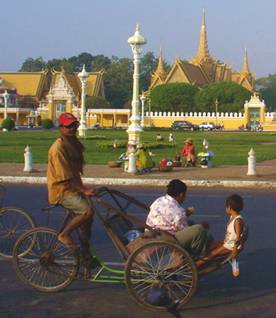 
Tricycle and
street sellers in front of the Royal
Palace at Phnom Penn
The road from the airport to Phnom Penn was bustling with activity,
dirty and crowded with street stalls selling piles of French golden
baguettes, amongst other things. Nearer the centre, the roads became large
regal avenues lined with frangipani trees in full blossom emitting the most
sensuous fragrance hiding the fumes of the traffic.
 
This was definitely the French touch which has been
so pleasantly continued right the way through what used to be considered the
loveliest of the French-built cities of Indochina.
Its charm, while tarnished has largely managed to survive the violence of its
recent history. The French left a legacy of now-crumbling colonial
architecture, some of which has been tastefully renovated into embassies and
other official buildings.
 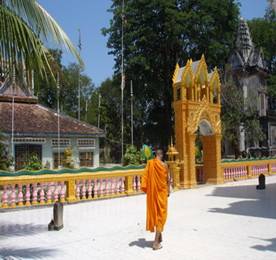
The Buddhist
temple-monasteries wats have come back to life with a passion – monks
in saffron robes can be seen wandering around the streets. Nowadays the
monks are learning how to become computer literate during their study time.
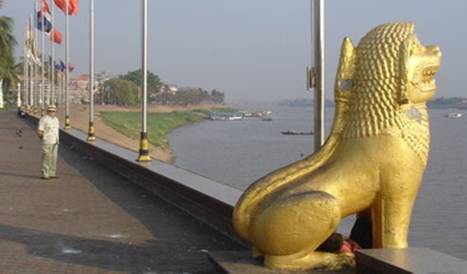
The riverfront is
most splendid, lined with palms and flags. The mightiest river in Asia, the Mekong, converges right alongside this city. Cafes,
hotels and restaurants are delightful places to sit and watch City and river
life go by.
 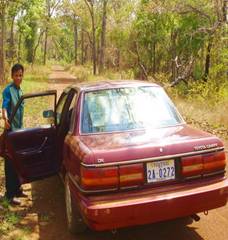
Elephants used to
be the way to get around, now we have a car and Mr Ben Wee
I checked the internet the night before we left and
found an English speaking Cambodian driver, Mr Ben Wee, with an air
conditioned car. We gave him a call the day we arrived and he agreed to
drive us all the way to Siem Reap,
in the North of the Country where the famous Angkor Wat ruins are located, and back down the other side
of the Tonle Sap lake over a period of 10 days. He
agreed the same rate it would have cost us to hire a car for ourselves should
that have been a possibility, which it isn’t, nor is it recommended in
Cambodia! Mr Ben Wee, our driver, confirmed that in the past two years, the
roads have been improved to make the journey pleasant. This is not likely to
last long, however, as for every $70 of road given by Aid organisations, the
Government pays $7 to the contractors for the road and pockets the rest! So
dirt roads just have a surface of tarmac spread over them, and become deeply
potholed and broken again within 6 months.
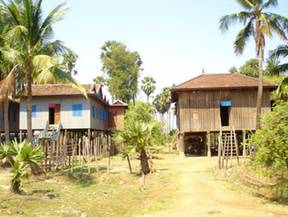 
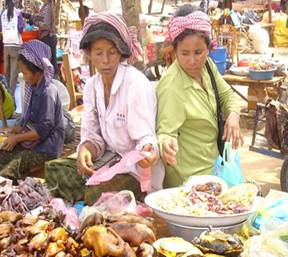
Small birds,
tortoises, large black hairy spiders, beetles and grubs are amongst the food
sold in the markets
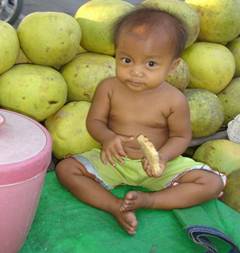
Baby-sitting amongst the Pomelos
The countryside is most attractive in the dry
season, which is during Jan to April. Houses are built on stilts (the ground
is flooded during the monsoons). They are all attractively styled with red
tiled roofs bordered in white with a carving at each apex, and outlined doors
and windows. The seem to sleep in hammocks under the house during the hot
dry season, together with the bullocks, chickens and pigs, and have their
kitchen down there too. 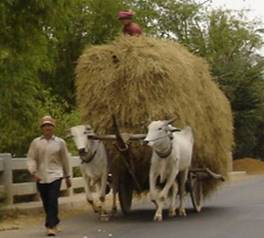
Rice hay to feed
the bullocks pulling the cart 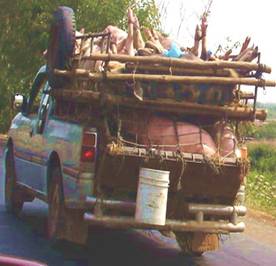
Live
pigs ready for the market
Cambodians have a proverb for every walk of life,
and the rampant problem of corruption is no exception. The saying goes
‘Small people take small bribes, big people take big bribes’ and
this aptly sums up the situation in Cambodia today. Puk roluy if Khmer for
‘corruption’ and translates literally as ‘something that is
rotten and should be thrown away’.
Corruption has been enslaving the people of Cambodia
since the 19th Century. After the death of Pol Pot Regime in
1998, it was the arrival of the United Nations that really sent corruption
spiraling out of control. Many of the members of the newly elected
democratic government were originally Pol Pot supporters! The injection $2
billion into the country’s tiny economy created a bonanza of
opportunity. Today, the situation is so bad that the government loses $100
million annually to illegal logging alone. The saddest part is that the
majority of Cambodians are extremely honest and their struggle to survive is
already hard enough without having to contend with widespread corruption.
Teachers are so poorly paid that they levy a charge for pupils to attend
class, preventing poor families from sending their children to school.
There is widespread begging at all the tourist spots
by children for this reason. We are so distraught at seeing children
begging, they find it is easy to earn money this way and therefore not bother
to go to school even when the odd note is handed to them, or if they manage
to sell their souvenirs.

Woman lighting
charcoal BBQ fire
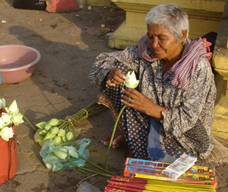
Lotus flower
and incense seller
I generally tried to always give something to the
older women. They are the pour souls who would have lost their sons during
the Khmer Rouge occupation. Without children to care for them, they have
nothing . Very few people in the world realize that nearly 3 million Cambodians were massacred in
the paddy fields close to their towns and villages. (compare this with the
one million Jews exterminated during WW2 and how little is made of this
genocide in Cambodia).
There are currently only 17 million people in this country – which is
mainly flat paddy fields. Pol Pot got to like power whilst believing in his
quest. There was so much blood spilt, that, when we visited one of the
killing fields near Phnom Penn, there are still bits of rag, teeth and bones
sticking out of the ground, which is washed away whenever there are heavy
monsoon rains. Fortunately the new post war generations is growing up
oblivious of the hardships of their parents, who unsurprisingly don’t
want to dwell on a painful past.
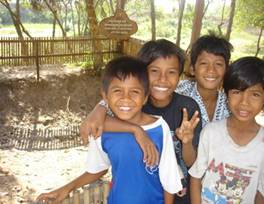
Boys smiling
beside mass grave of
beheaded Victims
of Pol Pot Regime
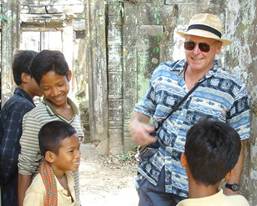
Young Cambodians
eager to try their English out on David at the Koh Kher ruins
Evil exists as a disembodied force, and I could feel
it darkening peoples hearts, at certain times and in certain places. But to
even suggest that, is one absolving the guilty of their crimes? Its easier
to prove the existence of evil. But if evil is a power at large in the
world, then surely good must be present too, and justice will be beyond the
efforts of human courts. Those men who were the torturers are now living
alongside their fellow citizens in the fields and towns we were visiting. I
asked our driver how his family cope with that. “We get used to the
fact that they did those atrocious things in order to save their own lives
and that of their families, they are the ones who have to live with their
conscience, and consequences of their actions!” Corruption needs to be
eradicated in Cambodia
(as it does in other countries suffering the same fate) before the country
can realistically travel the road to development. However, with low salaries
and little action, the country is set for many more years of puk roluy.
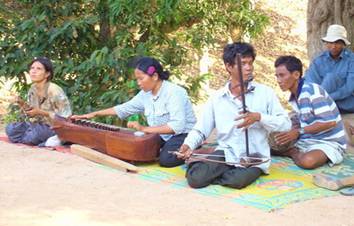
Land mine victims
playing traditional music
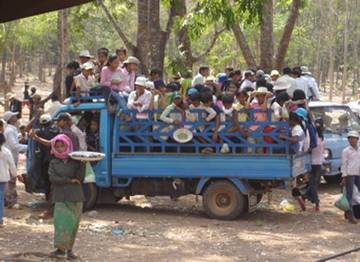
Truckload of
villagers leaving market
Land mines are still very much in evidence. It is
unwise to leave the main road even to have a pee. We saw mine detectors at
work along one stretch of the main highway from Siem Reap to the next big
town of Battambang, which is the road used by coaches arriving from
Thailand! So many people have lost limbs and therefore any means of earning
a living, they are mostly seen trying to sell photocopies of important books
for travelers, which we took advantage of occasionally, but could not
possibly give to them all. Many are taken in by charitable foundations, and
taught other skills in order for them to make a living, but most are unable
to leave their villages to take advantage of those places. Any military who
have been maimed are given a small pension, but most people that are maimed
used to be farmers searching in the woods for other sources of food or wood.

Ancient ANGKOR
WAT temples are the heart and soul of Cambodia, a source of artistic
inspiration and national pride to all Khmers as they struggle to rebuild
their lives.
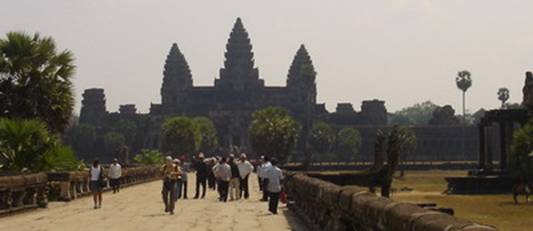
 

We arrived on a
Saturday, to witness many weddings using the Monument as the backdrop for
their photographic albums.
Built between the 9th and 14th
centuries AD, they are among the foremost architectural wonders of the
world. The right to dwell in structures of brick or stone was reserved only
for the gods. The wooden and bamboo homes belonging to the villagers who
constructed these massive temples have long gone. 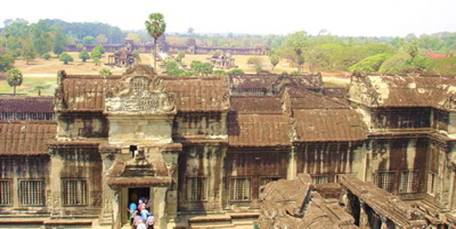
Angkor Wat is
surrounded by a moat, 190m wide, forming a giant rectangle measuring 1.5km by
1.3km. It makes the moats around European castles look like kid’s
play.
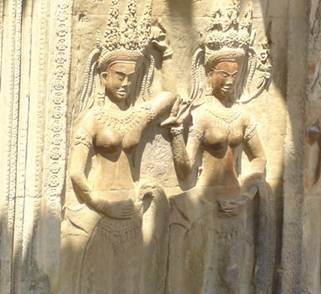
Bas-Reliefs of
two young ‘Apsara’ girls for the gods
Notice they are
wellrubbed by the tourists

Central Sanctuary
of Angkor Wat,
Surrounded by
these carvings
. .
The temples conjure up images of a golden age of
abundance the leisurely temple construction. This was constantly interrupted
by times of turmoil, conquests and setbacks caused by invasions from nearby Vietnam, Malaya,
Siam (Thailand) and Myanmar
(Burma).
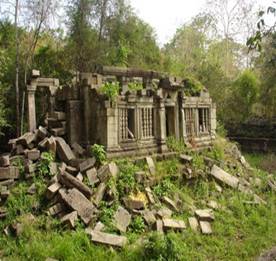
Part of Prei
Luck 700 ADin Northern Cambodia
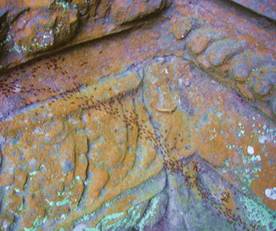
Armies of
ants destroying the temples
Armies of ants
are the one cause of the collapse of these temples. The incessant work of
armies of these insects burrowing beneath the earth supporting these stone
structures, causes subsidence and the massive walls and roofs to tumble over
under stress.
For centuries, the fount of royal divinity had been
with the Hindu deity Shiva, and Vishnu. But the Buddha of Compassion took
over during the reign of Jayavarman VII.
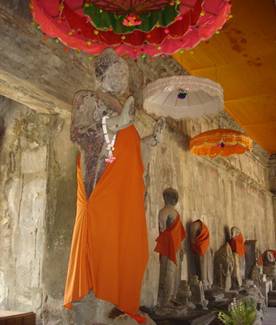
Statues of Buddah
cloaked in saffron robes in Angkor Wat

The Linga,
worshipped as divinity itself
So many temples of the early periods have been
swallowed by the jungle in the past 400 years, that they make very
atmospheric photos.
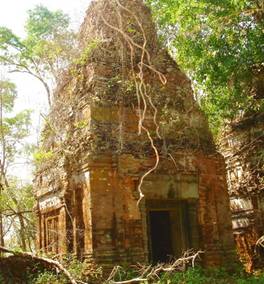

They are cloaked in dappled shadow, with crumbling
towers and walls locked in the slow muscular embrace of vast root systems.
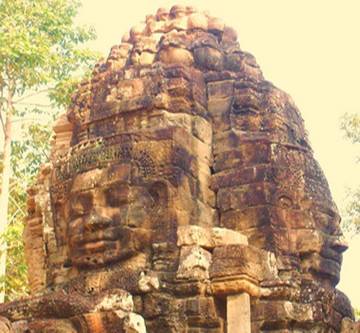
The face of their
god or their king conveys calm and peace at Ta Som
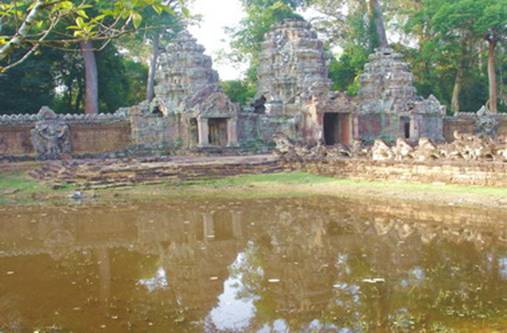
Ta Som entrance
reflected in the small moat surrounding it
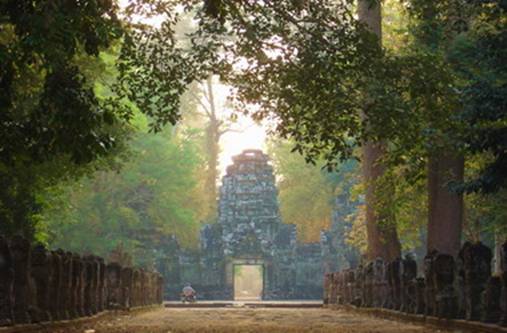
Early morning at
Preah Khan, magical entrance with birds singing
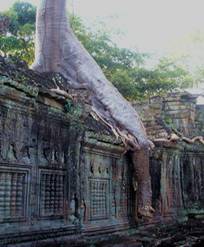
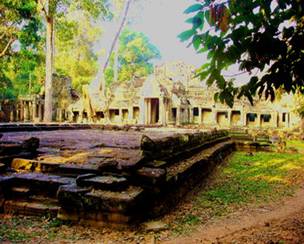
Ta Som engulfed
in roots of the Ficus trees
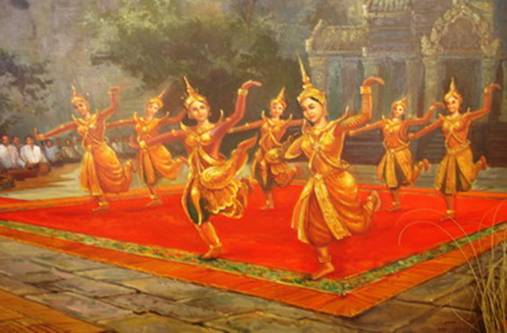
Modern painting
representing dancing girls performing for the King
We visited a rescue zoo where maimed tigers were
given a new chance, having been rescued from traps laid by poachers. One
female was so happy she even managed to produce a baby just a few months
ago. Many black asian bears were born in the zoo also, it’s too
frightening for them to be released back in the wild knowing that poachers
will be after them for Chinese medicine once more. Rare storks were anxious
to get back in the huge netted cage again, once they were released. They had
become too used to being fed a free meal of fish by their guardians!
 The 2
year old black asian bear loved the soft sweet coconut meat so much, he gulps
it down squeaking as if it was mother’s milk! The 2
year old black asian bear loved the soft sweet coconut meat so much, he gulps
it down squeaking as if it was mother’s milk!
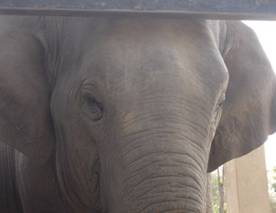
Two year old
elephant

50 year old
elephant in Phnom Tamao
Zoological Rescue
Park – sponsored amongst other charities by WILD AID

The Tonle Sap lake is
the largest in Southeast Asia. It’s an
incredible natural phenomenon that provides fish proteins and irrigation
waters for almost half the population of Cambodia. It has biosphere
status, as it is one of the world’s richest sources of freshwater fish,
as flooded forest during the monsoons makes a fertile spawning ground. Sadly
excessive deforestion, upstream dams of the Mekong river which feeds into it
and pollution by the Vietnamese
boat people living alongside the lake threatens to bring
destruction to the lake – a similar situation that marked the decline
of the 600 year old Angkorian empire.
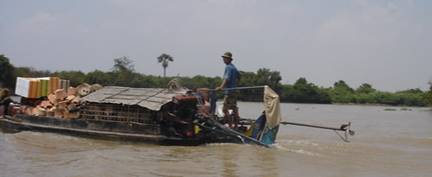
Freight delivery
by boat is faster than by bullock and cart

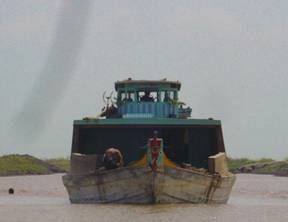
This Fisherman is
alongside the barge, on canal 15 leading off the Mekong River
‘Lonely Planet’ tells us that in 1997,
the government officially made about US13 million from the forests, but
illegal operations over the same period generated an estimated US185 million!
This is money that such a poor country can ill afford to lose, but with an
endemic culture of corruption there is little hope for the forests, when the
international community is unable to do much about it. Thankfully the seeds
laid by the huge trees which have been illegally logged will gradually grow
new trees again over the next hundred or so years, by which time maybe
illegal logging will be history!
25th March 2006, I just
picked up this report on BBC World news:
In recent
years, the study says, China
has emerged as the leading importer of tropical trees. The problem is that
much of this wood is illegally sourced and may come from rain forests and
other enviromentally sensitive areas.
The
numbers are huge.
The study
says exports of wood based products going from China
to Europe and the US
have gone up 900% in just eight years.
The
findings are the result of five years of collaborative research by
organsiations in the US, Indonesia and China itself.
An offshoot of the Chinese
Academy of Sciences in Beijing contributed to
the report
Other
factors cited include a big increase in demand for wood products in China
itself, and China's decision to impose a logging ban to protect its own
forests.
That's led
to more imports of illegal wood from elsewhere.
| 
